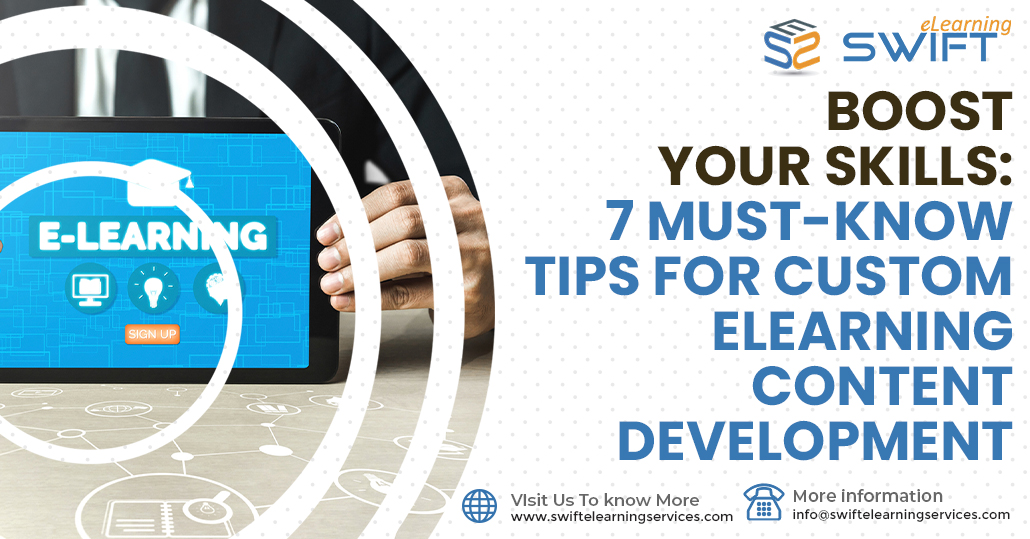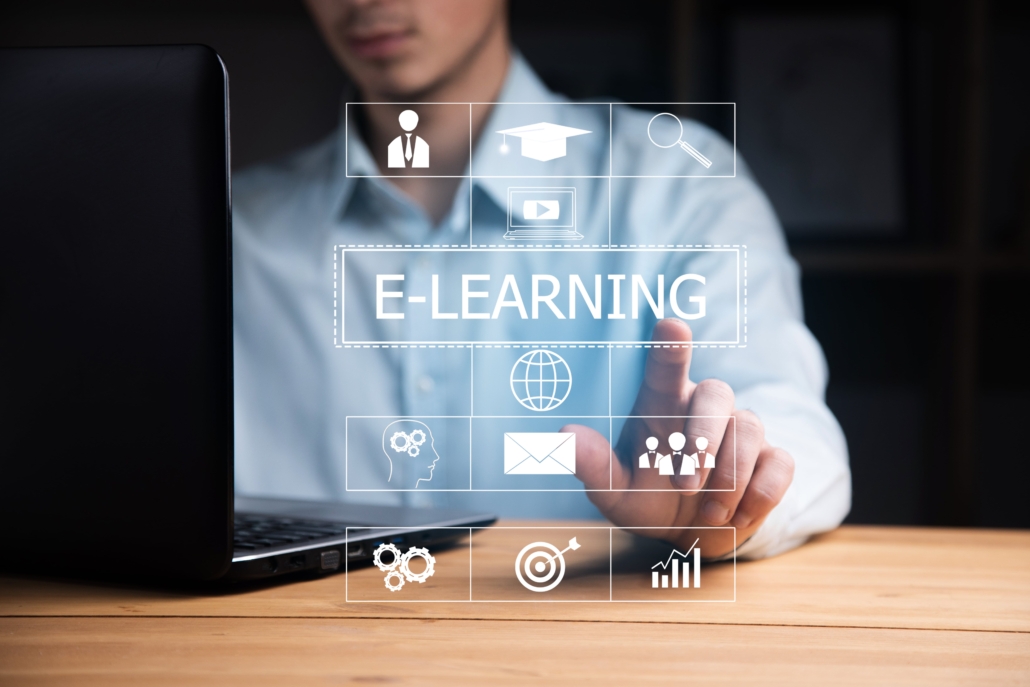Boost Your Skills: 7 Must-Know Tips for Custom eLearning Content Development
In today’s fast-paced world, the demand for online learning has skyrocketed. Whether you are an educator, a corporate trainer, or someone looking to create custom eLearning content for personal growth, the ability to develop effective and engaging eLearning materials is a valuable skill.
Custom eLearning content development allows you to tailor your courses to specific audiences, making learning more relevant and impactful. To help you boost your skills in this area, we’ve compiled seven must-know tips for custom eLearning content development.
1. Understanding Custom eLearning Content Development
Custom eLearning content development is the process of creating tailored educational materials for a specific audience or organization. It involves designing and developing digital learning experiences that meet the unique needs, goals, and preferences of learners. This approach to eLearning stands in contrast to off-the-shelf or pre-packaged courses, which may not address the specific requirements of a particular group of learners or the objectives of a specific organization.
To gain a deeper understanding of custom eLearning content development, let’s explore its benefits:
1.1 Relevance:
Customization ensures that the content is directly aligned with the organization’s or learners’ specific goals, needs, and industry requirements. This relevance enhances engagement and learning outcomes.
1.2 Flexibility:
Custom content can be adapted quickly to meet changing needs, whether it’s updating information, adding new modules, or addressing emerging trends. This flexibility is crucial in dynamic industries.
1.3 Cost-Effective:
While the initial investment in custom content development may be higher than off-the-shelf solutions, it often proves to be cost-effective in the long run. Customization allows organizations to create content that precisely matches their needs, reducing unnecessary expenditures.
1.4 Higher Engagement:
Tailored content is more engaging for learners. It can include real-world scenarios, examples, and case studies that resonate with the audience, making the learning experience more enjoyable and motivating.
1.5 Improved Learning Outcomes:
Custom content is designed with specific learning objectives in mind. As a result, it tends to lead to better learning outcomes and skill acquisition as compared to generic, one-size-fits-all solutions.
1.6 Enhanced Knowledge Retention:
Personalized content can leverage various instructional strategies, such as spaced repetition, scenario-based learning, and interactivity, which are known to enhance knowledge retention and transfer of skills.
1.7 Alignment with Organizational Goals:
Custom eLearning can be directly aligned with an organization’s strategic objectives and performance goals. This ensures that the training is not only educational but also contributes to achieving business outcomes.
1.8 Consistency:
Custom content allows organizations to maintain consistency in their training materials and messaging. This is particularly important for companies with a global presence or those needing standardized training across different departments.
1.9 Adaptation to Learning Styles:
Customization can take into account the diverse learning styles and preferences of the audience, including visual, auditory, kinaesthetic, and reading/writing learners, leading to a more inclusive learning environment.
1.10 Data-Driven Decision Making:
Custom eLearning platforms often provide robust analytics and reporting capabilities. Organizations can use this data to assess the effectiveness of training, identify areas of improvement, and make data-driven decisions to enhance learning experiences.
1.11 Brand Consistency:
Custom content can be designed to reflect the organization’s branding, values, and culture. This reinforces the organization’s identity and message, which can be particularly important for employee training.
1.12 Security and Compliance:
Custom content development allows organizations to address specific security and compliance requirements relevant to their industry. This is critical in sectors like healthcare, finance, and information technology.
1.13 Efficient Onboarding:
Custom eLearning content is especially valuable for onboarding new employees. It can provide them with the knowledge and skills needed for their roles while introducing them to the company’s culture and expectations.
1.14 Global Reach:
Custom content can be translated and adapted for different languages and cultures, making it suitable for international audiences and expanding the reach of educational programs.
1.15 Competitive Advantage:
Organizations that invest in custom eLearning content development often gain a competitive edge. Well-trained employees and effective training programs can lead to increased productivity and innovation.
2. Boost Your Skills: 7 Must-Know Tips for Custom eLearning Content Development
2.1 Understand Your Audience
Before diving into the content creation process, it’s essential to have a clear understanding of your target audience. Who are they? What are their learning preferences? What are their current knowledge levels? By conducting thorough audience research, you can design eLearning content that speaks directly to your learners’ needs and interests.
Start by creating learner personas. These fictional representations of your target audience should include details such as age, educational background, job role, and learning goals. This information will guide you in creating content that resonates with your audience and addresses their unique challenges.
2.2 Set Clear Learning Objectives
Once you’ve identified your target audience, the next step is to define clear learning objectives. Learning objectives are statements that describe what learners should be able to do after completing the eLearning module. They serve as a roadmap for your content development process and help you stay focused on what’s essential.
Learning objectives should be specific, measurable, achievable, relevant, and time-bound (SMART).
For example, instead of a vague objective like “Understand marketing principles,” a SMART objective could be “By the end of this module, learners will be able to analyze market trends, identify target audiences, and develop a basic marketing strategy.”
2.3 Design Engaging and Interactive Content
Engagement is key to effective eLearning. To keep your learners interested and motivated, consider incorporating various interactive elements into your content. This could include quizzes, simulations, case studies, and multimedia elements like videos and infographics.
Interactive elements not only make learning more enjoyable but also enhance retention and understanding. Additionally, they allow learners to apply their knowledge in practical scenarios, reinforcing their learning experience.
2.4 Embrace Micro learning
In today’s fast-paced world, learners often prefer bite-sized, easily digestible content over lengthy courses. Micro learning is an approach that delivers information in small, focused chunks. By breaking down your content into micro learning modules, you can cater to learners’ busy schedules and improve knowledge retention.
Each micro learning module should focus on a specific learning objective or topic, making it easier for learners to absorb information in short, meaningful bursts. This approach is particularly effective for just-in-time learning, where learners can access the content they need when they need it.
2.5 Prioritize Accessibility and Inclusivity
Custom eLearning content development should be accessible to all learners, regardless of their abilities or disabilities. Ensure that your content adheres to accessibility standards, such as WCAG (Web Content Accessibility Guidelines). This includes providing alternative text for images, ensuring keyboard navigation, and offering closed captions for videos.
Inclusivity is also crucial. Consider the diverse backgrounds and learning styles of your audience when creating content. Use plain language, avoid jargon, and provide multiple formats (text, audio, and video) to accommodate different learning preferences.
2.6 Leverage Technology Wisely
Technology plays a pivotal role in custom eLearning content development. Choose the right authoring tools and learning management systems (LMS) that align with your objectives and audience. These tools can streamline content creation, delivery, and tracking.
Additionally, consider incorporating emerging technologies such as augmented reality (AR) and virtual reality (VR) to create immersive learning experiences. These technologies can be especially effective for skill-based training, where learners can practice in realistic environments.
2.7 Continuously Evaluate and Improve
Custom eLearning content development is an ongoing process. After you’ve created and launched your content, it’s essential to gather feedback and evaluate its effectiveness. Use analytics from your LMS to track learner progress, engagement, and completion rates.
Based on this data and learner feedback, make necessary improvements to your content. Update outdated information, enhance interactive elements, and refine your learning objectives. Continuous improvement ensures that your eLearning content remains relevant and valuable over time.
3. Conclusion
Custom eLearning content development is a dynamic and evolving field that requires a combination of instructional design skills, creativity, and technological proficiency. By understanding your audience, setting clear learning objectives, designing engaging content, embracing micro learning, prioritizing accessibility and inclusivity, leveraging technology wisely, and continuously evaluating and improving your materials, you can boost your skills and create highly effective eLearning experiences.
Remember that the key to successful eLearning content is to put the learner at the centre of your design. Tailor your content to their needs and preferences, and you’ll not only boost your skills but also provide a valuable and impactful learning experience for your audience. So, roll up your sleeves, apply these tips, and embark on your journey to becoming a custom eLearning content development expert.
Frequently Asked Questions (FAQs)
What is custom eLearning content development?
Custom eLearning content development is the process of creating personalized digital learning materials to meet specific learning objectives, tailored to a particular audience or organization’s needs.
Why is understanding the audience important in custom eLearning content development?
Understanding the audience helps create content that is relevant and engaging. It ensures that the learning materials align with the learners’ preferences, prior knowledge, and learning goals.
What are SMART learning objectives in eLearning content development?
SMART learning objectives are Specific, Measurable, Achievable, Relevant, and Time-bound objectives that define what learners should accomplish after completing an eLearning module.
How can I make eLearning content more engaging?
You can make eLearning content engaging by incorporating interactive elements like quizzes, simulations, and multimedia, and by using storytelling techniques and real-world examples.
What is micro learning, and how does it benefit eLearning?
Micro learning is an approach that delivers content in small, focused chunks. It benefits eLearning by catering to busy schedules, improving knowledge retention, and allowing learners to access information when needed.
Why is accessibility and inclusivity important in eLearning content development?
Accessibility ensures that eLearning content can be accessed by learners with disabilities. Inclusivity means designing content that accommodates diverse learning styles and preferences, making learning more accessible to everyone.






Leave a Reply
Want to join the discussion?Feel free to contribute!